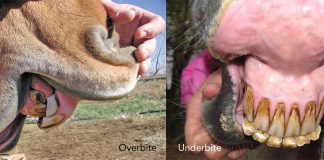
One of the most important tenets of horse keeping is: thou shalt keep the stall clean. Mucking your horse’s stall is the barn chore you treat like the doing the dishes—annoying as it is, it’s a necessity. Also like the dishes, if you miss a day, you’ll regret it!
On average, a horse passes about 1 to 1 ½ gallons of urine each time he empties his bladder. This urine contains its namesake, urea, a natural by-product of the breakdown of protein in a horse’s diet. Once voided into the environment, urea is naturally degraded into ammonia.
You may be familiar with ammonia in aspects other than horses. In liquid form, ammonia is used as a strong disinfectant and is also a major ingredient in fertilizer (and explosives). As a gas encountered in the barn, it can be anywhere from a minor irritant to a caustic inhalant. Data from humans shows that long-term exposure to ammonia can cause chronic inflammation in the lining of the respiratory system, as well as the eyes. Studies over the past fifteen years in horses indicate the same thing.
Consider additionally that your horse’s sense of smell is far more acute that your own. If you can smell ammonia in the stall or worse, in the aisle outside of the stall, imagine how strong it must be for your horse. So how can we help our stabled horses? Here are a few tips to help keep ammonia away.
1. Ventilation
The greatest issue with ammonia in a stall is that it collects in a small, enclosed place over time and unfortunately your horse is also in that same small, enclosed place for potentially long periods of time. In the summer it’s often simple to get those windows and aisle doors open for enough air ventilation to move ammonia out of the stall but come winter, an open barn isn’t as ubiquitous. Don’t let this be the case. No matter what the ambient temperature, get those windows and doors open to allow fresh air into the barn.
Sometimes, depending on the layout of the stalls, this isn’t enough, even in the summer. You can use fans for additional ventilation but take time to watch where the air goes. Fan placement is almost as important as their use itself; a fan that only swirls air around the stall isn’t doing anything to rid the area of ammonia. You need air movement that brings in fresh air.
2. Keep stalls clean
If you’re having trouble with strong ammonia fumes in your horse’s stall, consider how you’re cleaning it. Remember that soaked bedding will continue to hold urine, which emits ammonia. Just topdressing bedding with fresh stuff doesn’t rid the stall of fumes. Removing all soaked bedding regularly—ideally every day—is the best way to help reduce the odor in your horse’s stall.
Also consider how often you strip your horse’s stall completely. In general, it’s best to do this about once a week. For stubborn ammonia odors, consider using a commercial stall cleaner on the stripped stall floor to wash away old urine stains. Other commercial products can be added to the floor of the stall or to the bedding to help soak up urine and neutralize its odor.
3. Be a urine sleuth
If you keep your horse’s stall virtually spotless and are getting the best ventilation you can and are still having problems with a strong ammonia smell, dig a little deeper, literally. Examine the flooring of the stall. Cracks in the flooring and areas of uneven floor can create hidden urine pockets that are never drained. Dirt or clay floors can become saturated with urine, as can wood floors. If your horse’s stall has a mat, peek under that if you can. Urine can leak through seams in mats and collect underneath. Depending on the pitch of the floor, urine can also filter through cracks along the perimeter against the wall. If any one of these problems is present in your horse’s stall, consider investing in interlocking stall mats. These prevent seams, sit tightly against the walls, and inhibit leaks onto the sub-flooring.
4. Keep horses outside
This is by far the simplest solution for your ammonia woes, but it isn’t a viable option for some horse owners. The benefits of housing a horse outside are many, and the virtual non-existent worry about ammonia fumes is certainly on that list. If your horse can’t be outside all of the time, try to get him out as much as possible. Reducing his time in the stall not only lessens the urine build-up, but also provides his respiratory tract a breath of fresh air.
5. Consider a diet change
Ammonia comes from urea which comes from protein in the diet, so it stands to reason that reducing the amount of protein in your horse’s diet will also reduce, to an extent, the amount of ammonia produced from his urine. Alfalfa hay is a commonly fed roughage that is relatively high in protein. If ammonia is a consistent problem for your horse, consider changing his roughage to grass hay, which contains less protein. If you are concerned about adding calories to the diet, consider adding a complete feed or beet pulp to your horse’s ration to add in the calories lost from omitting the alfalfa.
Liked this article? Here are others you’ll enjoy:
Ask the Vet: Leaving the Barn Open in Winter
Better, Faster, Smarter Stall Cleaning






good tips1
We use Best Cob Premium Bedding & no longer have that ammonia smell. Makes it easier to clean stall too.
Great advice.
People that don’t know this don’t have any business owning a horse or any animal.